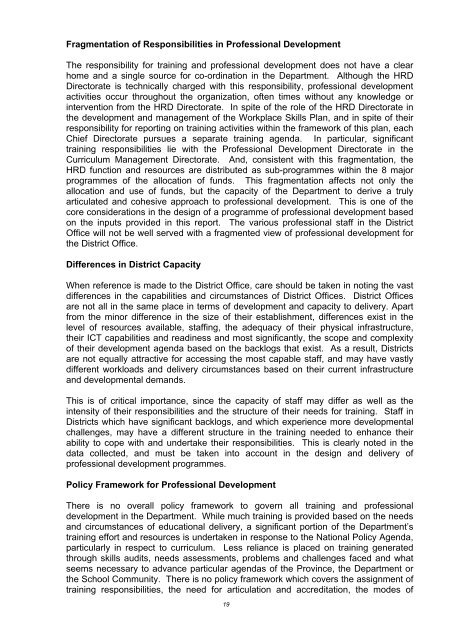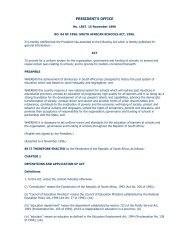Assessment of Needs and Capacity of District Office Professional Staff
Assessment of Needs and Capacity of District Office Professional Staff
Assessment of Needs and Capacity of District Office Professional Staff
You also want an ePaper? Increase the reach of your titles
YUMPU automatically turns print PDFs into web optimized ePapers that Google loves.
Fragmentation <strong>of</strong> Responsibilities in Pr<strong>of</strong>essional Development<br />
The responsibility for training <strong>and</strong> pr<strong>of</strong>essional development does not have a clear<br />
home <strong>and</strong> a single source for co-ordination in the Department. Although the HRD<br />
Directorate is technically charged with this responsibility, pr<strong>of</strong>essional development<br />
activities occur throughout the organization, <strong>of</strong>ten times without any knowledge or<br />
intervention from the HRD Directorate. In spite <strong>of</strong> the role <strong>of</strong> the HRD Directorate in<br />
the development <strong>and</strong> management <strong>of</strong> the Workplace Skills Plan, <strong>and</strong> in spite <strong>of</strong> their<br />
responsibility for reporting on training activities within the framework <strong>of</strong> this plan, each<br />
Chief Directorate pursues a separate training agenda. In particular, significant<br />
training responsibilities lie with the Pr<strong>of</strong>essional Development Directorate in the<br />
Curriculum Management Directorate. And, consistent with this fragmentation, the<br />
HRD function <strong>and</strong> resources are distributed as sub-programmes within the 8 major<br />
programmes <strong>of</strong> the allocation <strong>of</strong> funds. This fragmentation affects not only the<br />
allocation <strong>and</strong> use <strong>of</strong> funds, but the capacity <strong>of</strong> the Department to derive a truly<br />
articulated <strong>and</strong> cohesive approach to pr<strong>of</strong>essional development. This is one <strong>of</strong> the<br />
core considerations in the design <strong>of</strong> a programme <strong>of</strong> pr<strong>of</strong>essional development based<br />
on the inputs provided in this report. The various pr<strong>of</strong>essional staff in the <strong>District</strong><br />
<strong>Office</strong> will not be well served with a fragmented view <strong>of</strong> pr<strong>of</strong>essional development for<br />
the <strong>District</strong> <strong>Office</strong>.<br />
Differences in <strong>District</strong> <strong>Capacity</strong><br />
When reference is made to the <strong>District</strong> <strong>Office</strong>, care should be taken in noting the vast<br />
differences in the capabilities <strong>and</strong> circumstances <strong>of</strong> <strong>District</strong> <strong>Office</strong>s. <strong>District</strong> <strong>Office</strong>s<br />
are not all in the same place in terms <strong>of</strong> development <strong>and</strong> capacity to delivery. Apart<br />
from the minor difference in the size <strong>of</strong> their establishment, differences exist in the<br />
level <strong>of</strong> resources available, staffing, the adequacy <strong>of</strong> their physical infrastructure,<br />
their ICT capabilities <strong>and</strong> readiness <strong>and</strong> most significantly, the scope <strong>and</strong> complexity<br />
<strong>of</strong> their development agenda based on the backlogs that exist. As a result, <strong>District</strong>s<br />
are not equally attractive for accessing the most capable staff, <strong>and</strong> may have vastly<br />
different workloads <strong>and</strong> delivery circumstances based on their current infrastructure<br />
<strong>and</strong> developmental dem<strong>and</strong>s.<br />
This is <strong>of</strong> critical importance, since the capacity <strong>of</strong> staff may differ as well as the<br />
intensity <strong>of</strong> their responsibilities <strong>and</strong> the structure <strong>of</strong> their needs for training. <strong>Staff</strong> in<br />
<strong>District</strong>s which have significant backlogs, <strong>and</strong> which experience more developmental<br />
challenges, may have a different structure in the training needed to enhance their<br />
ability to cope with <strong>and</strong> undertake their responsibilities. This is clearly noted in the<br />
data collected, <strong>and</strong> must be taken into account in the design <strong>and</strong> delivery <strong>of</strong><br />
pr<strong>of</strong>essional development programmes.<br />
Policy Framework for Pr<strong>of</strong>essional Development<br />
There is no overall policy framework to govern all training <strong>and</strong> pr<strong>of</strong>essional<br />
development in the Department. While much training is provided based on the needs<br />
<strong>and</strong> circumstances <strong>of</strong> educational delivery, a significant portion <strong>of</strong> the Department’s<br />
training effort <strong>and</strong> resources is undertaken in response to the National Policy Agenda,<br />
particularly in respect to curriculum. Less reliance is placed on training generated<br />
through skills audits, needs assessments, problems <strong>and</strong> challenges faced <strong>and</strong> what<br />
seems necessary to advance particular agendas <strong>of</strong> the Province, the Department or<br />
the School Community. There is no policy framework which covers the assignment <strong>of</strong><br />
training responsibilities, the need for articulation <strong>and</strong> accreditation, the modes <strong>of</strong><br />
19

















